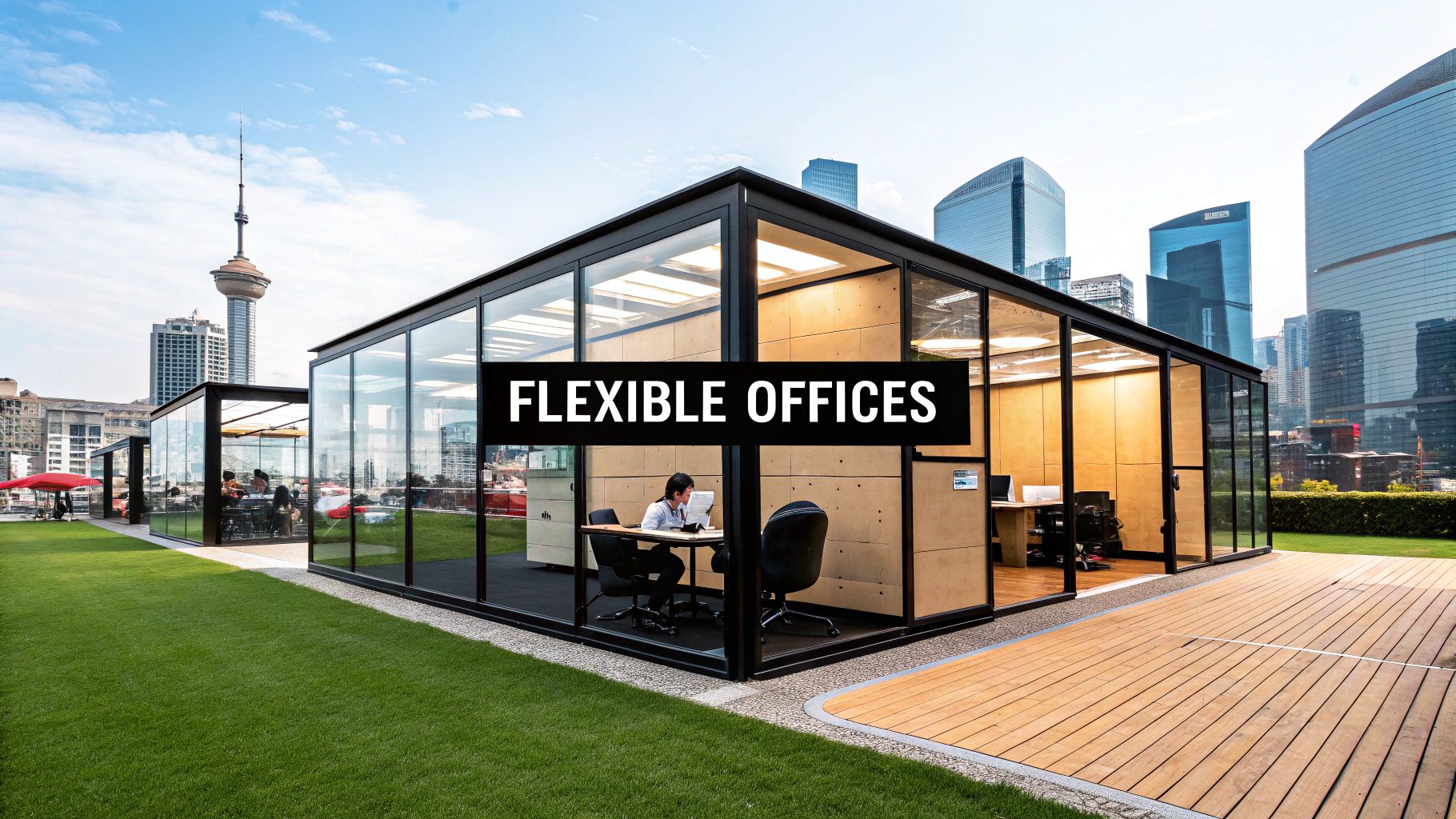Navigating Today’s Short-Term Office Rental Landscape
The modern business world thrives on adaptability. This has led to a significant change in how companies approach their workspace, with short-term office rentals becoming a popular strategy. This offers a compelling alternative to traditional long-term leases, allowing businesses to stay agile in a constantly evolving market.
For example, a project-based team can easily secure a temporary workspace for the duration of their assignment, avoiding the commitment and overhead of a long-term lease. This ability to quickly scale up or down is a major benefit in today’s uncertain economic climate.
Understanding the Shifting Market Dynamics
Understanding current trends in flexible work is vital for utilizing short-term office rentals. You can learn more about flexible work arrangements. The commercial real estate landscape has dramatically changed in recent years. In the past few years alone, the commercial real estate market, including short-term office rentals, has encountered numerous challenges.
Prior to 2024, the global office market witnessed five consecutive quarters of decreasing demand. Thankfully, a recovery started in the second and third quarters of 2024, with net absorption of office space turning positive.
This recovery is crucial for the short-term rental market, as it signals a growing need for flexible, temporary office solutions. Despite this positive trend, the office vacancy rate is still predicted to reach 24% by 2026, due primarily to the continued rise of remote work.
Many companies now hesitate to commit to traditional office spaces, which may lead to a greater reliance on short-term rentals. This shift is fueled by businesses searching for flexibility and cost-effectiveness in uncertain economic times. More detailed statistics can be found here.
Leveraging Short-Term Rentals for Strategic Advantage
Many organizations now recognize the strategic benefits of short-term office rentals. For those interested in learning more, this resource may be helpful: How to master short-term office rentals. These rentals provide more than just a workspace; they offer a way to optimize resources and boost operational efficiency. Short-term office rentals also give businesses access to prime locations and desirable amenities that might be financially out of reach with a long-term lease. This can positively impact client perception and improve employee morale. What’s more, temporary workspaces allow companies to test new markets before establishing a permanent presence, thus minimizing the financial risks often associated with expansion. This approach to workspace management allows businesses to react quickly to market changes and capitalize on new opportunities as they emerge.
Why Smart Businesses Choose Short Term Office Rentals
The modern business world thrives on agility and efficiency. For many companies, short-term office rentals provide a strategic advantage over traditional long-term leases, offering compelling financial and operational benefits. This shift is reshaping how businesses approach and utilize their workspaces.
Let’s explore why forward-thinking companies are embracing this flexible model.

This infographic showcases the key advantages of short-term office rentals, particularly within a modern coworking setting. It shows the benefits of flexibility, cost efficiency, and access to premium amenities.
These factors are drawing businesses to this model, ultimately contributing to enhanced productivity and adaptability in today’s ever-changing business climate.
Immediate Financial Benefits
Short-term office rentals offer immediate financial perks by eliminating the constraints of lengthy lease agreements. This frees up capital, allowing businesses to invest in core operations and other key areas. Moreover, unpredictable maintenance expenses, a common concern with traditional leases, are typically covered within the rental agreement.
The predictability simplifies financial planning and allows for better budget management.
Scalability and Adaptability
Flexible workspaces provide businesses with the ability to scale their operations quickly and efficiently. A rapidly expanding company can easily secure additional space as needed to accommodate new team members. On the other hand, during periods of downsizing, a short-term agreement prevents being tied to an overly large and underutilized office. This adaptability is very important for navigating market fluctuations and project-based work.
Access to Premium Amenities and Locations
Short-term rentals frequently grant access to prime locations and high-quality amenities, such as advanced meeting rooms, high-speed internet access, and professional reception services. These features improve the employee experience and create a positive first impression for clients. Often, these extra offerings are available at a fraction of the cost compared to securing similar resources through a traditional lease.
Companies can project a professional image and enjoy nice amenities without a long-term financial burden.
Reduced Expansion Risks
Expanding into new markets presents inherent uncertainties. Short-term office rentals provide a practical solution for exploring new territories. Businesses can establish a temporary presence and thoroughly evaluate market viability before committing to a permanent location. This approach diminishes financial risk and promotes informed decision-making, supporting sustainable growth and well-informed business strategies.
To further clarify the distinctions, let’s look at a comparison of short-term office rentals and traditional leases:
Short Term vs. Traditional Office Leases Comparison:
This table compares the key differences between short term office rentals and traditional long-term leases across important factors for business decision-makers.
| Factor | Short Term Office Rental | Traditional Long-Term Lease |
|---|---|---|
| Lease Term | Flexible (months to a year) | Typically multi-year (3-5 years or more) |
| Cost | Lower upfront costs, predictable monthly expenses | Higher upfront costs, potential for unexpected expenses |
| Scalability | Easy to scale up or down as needed | Difficult and costly to adjust space |
| Amenities | Often includes access to premium amenities | May require separate contracts and fees for amenities |
| Flexibility | Greater flexibility to relocate or change workspace | Limited flexibility, locked into lease terms |
| Risk | Lower risk for market entry and expansion | Higher risk due to long-term commitment |
As the table illustrates, short-term rentals offer distinct advantages regarding flexibility, cost control, and scalability, making them an increasingly popular choice for businesses in today’s dynamic market. The ability to adapt quickly to changing circumstances while minimizing financial risk makes short-term office rentals a compelling alternative to traditional long-term leases.
Exploring Your Short-Term Office Rental Options
The short-term office rental market offers diverse choices tailored to specific business needs. Understanding these options is key to making the right decision for your organization. This section explores the various types of short-term office rentals, highlighting their benefits and typical applications.
Coworking Spaces: Fostering Collaboration
Coworking spaces offer shared work environments where individuals and teams from different companies work together. These spaces are known for their energetic atmosphere and networking opportunities.
They typically include amenities such as shared desks, meeting rooms, high-speed internet, and kitchen facilities. Coworking is ideal for freelancers, startups, and small teams seeking a collaborative environment and flexible terms. Many businesses find that temporary storage can be a helpful solution during transitions.
For example, temporary storage can offer a cost-effective way to manage inventory or equipment between moves.
Serviced Offices: Turnkey Solutions for Professionals
Serviced offices provide private, fully furnished office spaces with a full suite of services. These often include reception services, administrative support, IT support, and mail handling.
Serviced offices are well-suited for businesses that require a professional image and a ready-to-use workspace without the administrative burden of managing their own facilities. This option is particularly attractive for established businesses seeking temporary or project-based space.
Virtual Offices: Establishing a Presence Without the Overhead
A virtual office offers a business address and communication services without requiring a physical office space. This provides a professional image and access to services like mail forwarding, phone answering, and meeting room access.
Virtual offices are a budget-friendly choice for businesses that operate primarily remotely or require a business presence in a particular location without the cost of a full office.
Temporary Private Suites: Confidentiality and Flexibility
Temporary private suites provide dedicated, enclosed office spaces offering privacy and confidentiality. These suites are perfect for teams working on sensitive projects or needing a quiet, dedicated workspace. They often come furnished and equipped with essential amenities, offering a convenient and adaptable alternative to traditional leases.
Market Trends and Considerations
The demand for flexible workspaces is shaping the short-term office rental market. The broader short-term rental market has experienced growth, with a 9% increase in listings and guest capacity between December 2023 and December 2024. In some areas, like Asia and Africa, this growth was even greater, with guest capacity increases of 22% and 25% respectively.
This rising popularity of flexible arrangements, influenced by remote work and other factors, points to a potential surge in demand for short-term office rentals as companies adapt to changing work patterns. Find out more numbers on this here.
When choosing a short-term office, consider factors such as location, amenities, lease terms, and pricing across different markets. Understanding these key aspects and aligning them with your business needs enables a better, informed decision that supports your operational efficiency and business goals.
Finding Your Perfect Short Term Office Space Match
Finding the right short term office rental requires careful planning. This guide will help you locate a space that truly fits your needs and supports your business objectives. We’ll cover everything from searching for available options to assessing potential locations and negotiating the best possible terms.
Identifying Potential Short Term Office Rentals
Your search begins with exploring all available avenues. Start by checking out online platforms that specialize in short term office rentals. Then, connect with commercial real estate brokers. Brokers offer valuable market insights and access to a wide range of listings.
And last but not least, consider reaching out directly to office space providers, especially if you have specific buildings or locations in mind.
Evaluating Your Options
Once you’ve identified several potential spaces, a thorough evaluation is essential. Location accessibility is key. Think about how easy it will be for your employees and clients to reach the office. Assess the reliability of the connectivity infrastructure. Is the internet service robust enough to handle your needs?
Examine the building’s security protocols to ensure the safety of your team and equipment.
Finally, consider the flexibility of the space configuration. Can it be easily adapted for different team sizes or project requirements? Does it offer a good mix of open collaborative areas and private offices?
Check out our guide on flexible workspace solutions for more detailed insights.
Conducting Effective Property Tours
Property tours are invaluable. They allow you to experience the workspace firsthand. Before your tour, prepare a list of questions. This will help you uncover potential issues that might not be obvious at first glance. Inquire about the building’s maintenance history, the responsiveness of the management team, and the availability of support services. Don’t hesitate to ask about previous tenants’ experiences.
Negotiating Favorable Terms
Effective negotiation can significantly impact your rental costs and contract terms. Research market rates for similar spaces in the area to give you a strong negotiating position. Explore potential concessions. These might include flexible lease terms, a rent-free period, or included amenities.
Providers are often willing to negotiate, especially with well-informed prospects.
Using the Short Term Office Rental Evaluation Checklist
The following checklist outlines the essential factors to consider when evaluating potential short term office spaces. It will help you stay organized and ensure you don’t overlook any crucial details.
Short Term Office Rental Evaluation Checklist
| Evaluation Category | Key Considerations | Priority Level |
|---|---|---|
| Location | Proximity to transport, amenities, client base | High |
| Infrastructure | Internet speed, phone lines, IT support | High |
| Security | Access control, surveillance systems, alarm systems | High |
| Flexibility | Space configuration, lease terms, scalability options | Medium |
| Amenities | Meeting rooms, kitchen facilities, parking availability | Medium |
| Cost | Rent, utilities, additional fees | High |
| Contract Terms | Lease duration, renewal options, termination clauses | High |
This checklist highlights the critical areas to focus on, from location and infrastructure to cost and contract terms. Prioritizing these elements will help you make informed decisions.
By following these steps and using the checklist, you can secure a short term office rental that optimally supports your business operations and goals. This allows you to concentrate on your core activities while enjoying a flexible and cost-effective workspace solution.
Mastering the Financial Side of Short Term Office Rentals

Understanding the financial aspects of short-term office rentals is crucial for getting the best value and avoiding surprises. This section explores the various financial factors to consider, going beyond just the basic rental price, to help you make smart decisions.
Decoding the Costs: Transparent and Hidden
The total cost of a short-term office rental involves more than just the advertised rate. Some costs are clear, like utilities and internet. Others are less obvious. For example, some providers have extra charges for services like printing, mail, or after-hours access. Understanding all potential costs upfront is key to comparing different options accurately. Learn how to master coworking space costs. This knowledge will help you evaluate various pricing structures and avoid unexpected expenses.
Comparing Pricing Structures
Providers use different pricing models. Some offer all-inclusive packages that bundle everything into a single monthly fee. Others use a fee-based approach, charging separately for each service. Understanding these models is important for making accurate comparisons.
An all-inclusive package might seem pricier at first, but could save you money if it covers everything you need.
A fee-based structure lets you pay only for what you use, which might be preferable if you have limited requirements. Consider your expected usage and needs when evaluating these pricing models.
Negotiation Techniques for Securing Discounts
Negotiating is key to a good rental agreement. Don’t hesitate to negotiate terms like the rental rate, lease length, and included amenities. For a longer rental, you might be able to negotiate a lower monthly rate. If you don’t need certain amenities, you might get a discount for excluding them. Knowing the market rates for similar spaces in your area will give you an advantage.
Leveraging Market Fluctuations and Value-Added Services
Seasonal market changes affect pricing. Demand for office space often shifts throughout the year. Understanding these trends can help you find better deals during slower periods. Also, think about value-added services that could boost your return on investment.
Some providers offer networking events, workshops, or access to shared resources like 3D printers. These extras can benefit your business and might justify a slightly higher price.
By fully grasping the financial side of short-term office rentals, you can manage your budget effectively, negotiate well, and pick the best solution for your business. This careful planning sets your business up for both immediate success and future growth.
Future-Proofing Your Short-Term Office Rental Strategy

The short-term office rental market is constantly changing, adapting to new technologies, evolving work styles, and economic shifts. This section explores the key trends shaping the future of temporary workspaces and what they mean for your business.
The Rise of Hybrid Work Models
Hybrid work is becoming the norm. Employees now divide their time between working remotely and being in a physical office. This creates a demand for flexible workspaces that support both collaboration and focused individual work. These spaces must seamlessly integrate technology and offer adaptable configurations.
Short-term office rentals offer the agility businesses need to adjust their workspace as their hybrid models develop.
Technology Integration: A Non-Negotiable Feature
Technology is essential in today’s workspaces. High-speed internet, smart building features, and intuitive digital experiences are now expected. Integrated booking systems for meeting rooms, touchless entry, and real-time occupancy tracking are becoming commonplace.
Short-term office rentals are meeting these demands with advanced technology infrastructure. This ensures businesses stay productive and connected, wherever they choose to work.
Wellness and Sustainability: The New Competitive Edge
Wellness-focused design and sustainable practices are now vital. Think natural light, good air quality, and ergonomic furniture. These features not only improve employee well-being but also attract and retain talent. Businesses prioritize these factors when selecting a workspace.
Short-term office rentals are responding by incorporating these elements, creating healthier, more appealing, and environmentally conscious workplaces.
Market Dynamics and the Future of Short-Term Rentals
The broader office rental market impacts the short-term sector. The market is recovering, with global leasing activity up in the first quarter of 2025 across all regions, despite economic uncertainty.
Reduced downsizing and lease expirations contribute to this. However, new office space remains limited, especially in North America and Europe, driving up rent and fit-out costs. This shortage could increase demand for short-term office rentals as businesses seek alternatives to traditional leases.
The trend toward office renovations and investment to meet modern workplace needs may further highlight the value of flexible, short-term rental solutions. Learn more about these trends from JLL. These market dynamics highlight the importance of considering these trends when developing your short-term office rental strategy.
By understanding and adapting to these future trends, your business can use short-term office rentals strategically. They become more than just temporary solutions; they are tools for long-term success. This proactive approach ensures your workspace supports your business goals and enhances your competitiveness.
Ready to find the perfect short-term office for your needs? Visit deskhop to explore flexible and convenient workspace solutions that empower your business for the future.




